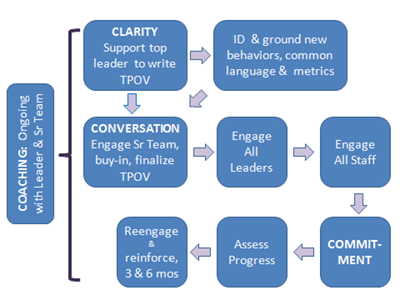Stop trying to be NICE about culture shift.
Slow and gentle can work … eventually. But think about it: Wading slowly into the shallow end of a pool merely extends the pain of getting in the water.
Instead of being nice, we invite you to be CLEAR about where you are going. Invite everyone into the conversation, and create a common language and set of expectations that will have everyone on your team excited about – and committed to – a new future.
When you quickly pull everyone into the deeper end of the pool, you save time and money, get your team bonded and working together faster, and move the organization where it needs to be ahead of schedule – all with less pain!
Rapid Culture Assimilation™ will help you and your team live your new vision sooner, faster, and deeper.
This immersion approach to organizational culture shift can cut many months off a typical 18-24-month implementation timeline AND help address the toughest aspect of change – how people behave.
What are YOUR catalysts for organizational shift?
Merger? Acquisition? New leader with a new vision? Reorganization? New software? Competitive pressure? Customer dissatisfaction? Implementing Lean/Six Sigma? Financial difficulties? A new direction for the organization? Globalization?
The plans for change usually look great on paper. Yet, a large percentage of changes fail to deliver on the promise.
Let’s speak the TRUTH about why so many change initiatives fail:
- People resist change! Change initiatives rarely bog down due to a “bad idea.” Humans are programmed for stability – so we resist learning and shun commitment. If your people aren’t involved in designing the change, you won’t have their commitment … and nothing happens.
- Change creates uncertainty. Unless one makes a living as an adventure guide, there is a big part of each of us that needs Tomorrow to look like Today, to look like Yesterday. We want to know where to sit and what to do. Once a change is declared imminent, we get anxious! The longer the period of uncertainty, the more insecure we feel, and the more likely we are to disengage or even leave the organization … which necessitates a further change in plans, which adds time … and on and on.
The biggest breakdown in culture shift often occurs here. To avoid making mistakes or making waves, many organizations shift into “study mode” – evaluating the current systems and people, conducting gap analyses, etc., allowing them to hide behind the perception of activity. But let’s face it: Everyone already knows what’s not working.
What’s really needed is a leader who has the courage and the tenacity to stick to the change decision and move the organization quickly through the period of uncertainty. But …
- Organizational inertia is powerful. The Titanic did not hit an iceberg because people did not see it or failed to understand what it was. They collided because it takes a long time to course-correct something that big with one person working a single rudder. Change will not happen if you are the only person pulling for the change.
- Everyone sees the world differently. Each of us has a slightly different set of work/life experiences through which we filter all communication; even when you work hard to deliver a consistent message, people will hear it differently than you intend. For example, words you might choose for their positive meaning can actually create negative reactions in someone else.
What do you REALLY want from a successful change initiative?
When you consider where you and the organization will be after the change is complete, you probably get excited about moving forward. You’re hoping that:
- Everyone cares as deeply as you do, and the new vision is clear and universally supported.
- Conversations change! They turn to “what is required to make this happen?” The air crackles with possibility.
- New behaviors, new terminology, and new priorities easily become the norm, while outmoded habits disappear.
- People easily shift to new processes without downtime or loss of quality or service.
- Employees feel connected. No one leaves, because they are happy with the new order.
- New outcomes are observable immediately. Productivity and creativity soar, costs manage themselves, the P&L improves, customers beg for more, and you have to hire more people to staff your rapid growth.
Sound like a fantasy world? Maybe. Yet these can be real outcomes when you make Conversation as important as Implementation.
The solution? Rapid Culture Assimilation.
This multi-phase process dramatically accelerates the shift necessary to support the success of four common organizational changes:
Culture (the system of shared meaning; how we do things here)
- Technology (what supports how work gets done)
- Structure (how people and work are organized)
- Process (the work itself)
… and often several of these are intertwined.
Rapid Culture Assimilation engages every member of the organization in a conversation to understand what you expect of THEM, and seeks to enroll them in the changes. This means leaders can shift from pushing change from above to collaborating with their people to accomplish and be accountable for it together.
What’s the Secret to Success?
Rapid Culture Assimilation succeeds on a foundation of four Building Blocks: Clarity, Conversation, Commitment, Coaching and Accountability.
Read more about the Four Building Blocks here
Are there other benefits from the RCA process?
When you engage the four building blocks, you and your organization can expect significant, positive benefits, including:
- Greater clarity around expectations and non-negotiable values.
- Development of a Common Language around the elements of the new culture, which might include communication, decision-making, managing people and work, and the very concept of change.
- Identification of what must change (e.g. leadership behaviors, communication processes) to meet the new expectations.
- A personalized commitment – from every person at every level – for making such changes.
- Faster implementation of the new organization structure, language, processes and methodologies, and/or culture.
- Improved productivity and a reduction in undesirable turnover, as your teams move more quickly from a distracted “what’s my future?” state to feeling focused and committed.
- An outside partner to the top leader(s) and Human Resources, who will provide objectivity, ask the tough questions, help get to the core of issues, and hold them accountable to do what they say they want to do.
What’s the origin of RCA?
I developed this process in the 1990s after being recruited as Chief Change Agent/HR Director for a national insurance company with multiple regional offices and a new CEO who needed to fast-forward the company’s culture 25 years… “NOW”. This process helped us replace a long-entrenched entitlement culture with a more entrepreneurial, metrics-driven one in just six months. We suffered minimal turnover, and were able to return the organization to profitability ahead of the initial goal established by our investors. I have since helped a dozen companies or divisions navigate the process, with similar outcomes.
How Does It Work?
Rapid Culture Assimilation is a guided process that takes a leader’s articulated vision for the culture of an organization and moves it from their head onto paper and then embeds it in the language and behavior of the people in that organization.
On a high level, it works like this:
Rapid Culture Assimilation Process Flow
1. Clarity
We work with the top leader(s) to co-create a powerful and concise document that will serve as the foundation and the catalyst for the assimilation conversations.
2. Conversation
We create a series of facilitated conversations/retreats, cascading down and throughout the organization, bringing people at all levels together to examine, challenge, and refine a new “common language” of culture, including new behavioral and work expectations.
3. Commitment
Every conversation/retreat will wrap with a commitment exercise in which participants personally reflect on what they will do (or stop doing) to support the change. They put that commitment in writing.
4. Coaching and Creating Accountability
Over the next year, I support the senior leader in a 1:1 executive coaching relationship, and the leadership team in a group coaching process to support them in leading and modeling the new culture.
In addition, we follow-up on the Individual Commitments made by all participants, administer cultural pulse surveys, and facilitate regular group conversations where participants check in and renew/recalibrate those commitments.
Is Rapid Culture Assimilation a solution for YOU?
The ideal client for RCA is a CEO, C-level manager, or leader of a discrete organizational unit. Past clients included:
- The new President of a regional service firm who wanted to shift the culture to focus on service.
- CEO of a $2B east-coast insurance company merging with a sister company in the Midwest who needed to complete the integration process within six months.
- The new CIO of a 2,000 person F500 IT division who sought to transition from a culture of “rogue tribes” to operating off a common platform and mindset.
- An Operations SVP moving to a flatter, team-based organization that required everyone be actively engaged in Creative Destruction for the sake of the organization’s survival – even as they knew that 2/3 of their jobs would not exist once the evolution was complete.
- The Director of a Creative Division seeking to overhaul a decades-old structure and mindset to increase creative output.
The RCA process is most effective in situations where the leader-in-charge (possibly you, the person reading this page) has declared a new future for the organization, has a desire to move rapidly through the period of change and uncertainty, and seeks to retain as many of their people as possible.
The ideal RCA client is willing to invest more time Now to engage people, with the understanding that investment will pay off in faster implementation, deeper commitment to the new reality, and higher levels of performance.
RCA is not appropriate for those who prefer to ram through changes from a “because I said so” mindset, or for those who consider major employee turnover to be a “necessary cost” of change.
The RCA process has proven to work even when these “complications” exist:
- Staff and/or leaders work in virtual teams across multiple states/countries.
- Key stakeholders are resisting the change(s).
- The final implementation threatens jobs.
- And even when the leader-in-charge is still unclear about the change (the first step in the RCA process is creating that clarity!)
Ready to take the next step?
If at this point you are curious about how the Rapid Culture Assimilation process can help your organization create real change, real fast, I invite you to contact me for a complimentary RCA Strategy Session.
The conversation will take about an hour by phone. We’ll explore what changes you want to create for your organization, the core message you want everyone to “get”, and whether this customized assimilation program may be of help or not. Whatever the outcome, you will leave the conversation with more clarity about the issues you are facing and excited about what is possible.
Contact me today to book a Rapid Culture Assimilation™ Strategy Session – I am Happy to speak with you.
In Happiness,

Jim Smith, PCC
Rapid Culture Assimilation™ is an unique offering from The Executive Happiness Coach®.




